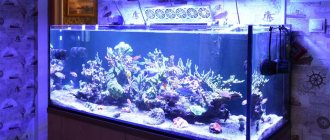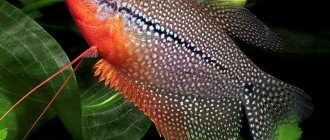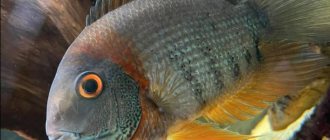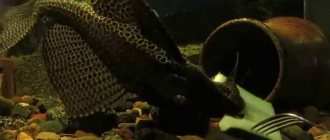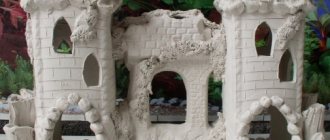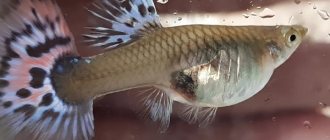Catfish
Simplicity of content:
Latin name: Corydoras
Lifespan: 5-9 years
Maximum size: 7 cm.
Average cost: 50-1500 rub.
The Corydoras fish is a small armored catfish that naturally lives in the Amazon and Orinoco river basins. Corydoras catfish prefers to live in warm, fresh, soft water with a muddy-sandy bottom. This is the best fish for inexperienced aquarists because it is absolutely easy to care for. The catfish enjoys playing catch-up, and also organizes active games with other individuals, delighting the interesting behavior of its owners.
Description
The Corydoras catfish has a miniature size, approximately 3–7 cm; specimens with a length of 10 cm have been recorded. The body resembles a spindle, flattened to the tail. The back has a convex shape. The mouth is at the bottom. Near it there are 3 pairs of antennae that help the fish dig up the bottom of its habitat. At home, catfish live up to 15 years.
Corydoras are excellent orderlies: most of the time they dig in the ground, clearing the reservoir of contaminants.
A distinctive feature of the catfish is its shell, consisting of bony plates. They are located on the back in 2 rows. Most often you can find an olive-grayish color or pale pink; sometimes there are white corydoras with red eyes - albinos. Males have brighter colors.
The female catfish is much larger than the male. Its dorsal fin has a rounded shape, while that of the male is sharp. The end of the pectoral fin of the catfish is also sharp, so it can tear the net for catching.
Corydoras in water breathe through gills. To capture air at the surface of the water, they use intestinal respiration.
How to distinguish a male from a female
For clarity, an image is presented above that helps to better distinguish the males of this group of fish from the females. In fact, this is not very easy to do (after all, you can see from the image that the male and female are very similar).
But usually the “girls” are larger and their body coloring is more beautiful, the fin on the back is round and short.
The fish reach sexual maturity at about eight months of age and are then able to reproduce to the delight of their owner.
Types of Corydoras
Experts count more than 150 species of corydoras.
There are a huge number of subspecies of Corydoras catfish
Golden (bronze)
Color – golden with a bronze tint. There is a shiny line on the back. This species is native to Venezuela and Trinidad. An individual can reach a length of 7 cm. The bronze corridor needs a water temperature of 21 to 26°C.
Mottled
This species is most often found among corydoras catfish. The length of the male is on average 5 cm, and the female is 7 cm. The color of the speckled corydoras is olive-gray. Each individual has its own form of black spots located on the body. The fish are unpretentious. Able to withstand temperature fluctuations from 4 to 30 ° C (I hope you won’t check). Speckled catfish reproduce in any conditions.
Panda
The size of this catfish is 3 - 5 cm. The color of the fish is light, sometimes with a pink tint. The catfish has black spots on the dorsal fin and tail, as well as a black mask on the eyes. The coloring gives the species its name. Found in the Peruvian Ucayali River. They love water above 17 °C. They can tolerate temperatures up to 12 °C for no more than 4 hours. They prefer dim light. To live in an aquarium and successfully breed, pandas need clean, slightly acidified warm water (22 ° C), as well as constant aeration.
Shterba
Range: river basin of Bolivia and Brazil. A 5 cm fish with a dotted pattern on its body. On the tail the pattern turns into stripes. The color of this species of corydoras is dark brown. The pelvic fins are bright orange. Adult catfish have red rays on their pectoral fins.
Shterba catfish can change color to match the color of the soil.
Adolfi
A small fish, 5 cm long. It has a light gray color. There is a mask over the eyes, like that of panda catfish. The back of the head is decorated with an orange speck. A longitudinal black stripe runs along the back. Habitat: Rio Negro River. This species requires more careful care and maintenance. It does not reproduce in captivity and lives no more than 6 years. The individual is very shy.
Leopard
Beautiful catfish. The color is brilliant yellow with black spots, similar to a leopard skin. The length of the individual is 6 cm. Another name for the catfish is trilinear, because of the three lines that run across the entire back (in males), from the middle of the back to the tail (in females). Looks interesting against the background of dark gravel.
What diseases are they susceptible to?
If these pets are not provided with suitable living conditions, they may become ill. Most often these are bacterial and fungal infections. Corydoras often suffer from fin rot and helminthiasis. Some aquarists experience poisoning due to excessive concentrations of nitrates, phosphates and other compounds.
Fungus
It can be identified visually by various spots, growths and plaque on the body of the fish. In this case, the treatment takes place in a special jigging container. Among the medications you can choose potassium permanganate (5-minute baths), furatsilin (1 g per 10 l). You also need to be careful with the last drug. The fish is placed in the container daily, but for no more than half an hour. Under no circumstances should you use salt, as these animals cannot tolerate salinity in the water and die quickly.
Poisoning with nitrogen compounds
If the fish often begins to stay near the surface and gasp for air, then it means that there is an excess of nitrates, phosphates and other harmful substances in the water. Ideally, you should test your water for the presence of these compounds.
The solution to the problem is simple - you need to make a replacement. First, you can replace half the volume of the aquarium, and then you should monitor the behavior of the fish and the concentration of nitrogen compounds.
Character and relationships with neighbors
The aquarium fish Corydoras has a calm disposition. Feels good in a flock of 5–8 individuals. Most of the day the fish is at the bottom of the tank.
Corydoras in the waters of a community aquarium are compatible with fish of the same size, these are:
- guppy;
- platies;
- gourami;
- discus;
- zebrafish;
- angelfish;
- swordtails;
- mollies;
- cockerels (in a large aquarium), etc.
Before choosing neighbors, check out the table!
Mastacembelus, eels, shrimp, astronotus are not the best companions for corydoras. Catfish should not be housed with cichlids or Koi carp. Corydoras is not compatible with any aggressive aquarium predators.
Compatibility
Corydoras themselves are very peaceful fish. They live in the bottom layers of the aquarium and do not cause trouble to their neighbors.
Catfish get along well with various types of viviparous fish (for example, guppies, swordtails, mollies and platies); their neighbors can also be neons, angelfish, barbs and tetras, and various types of dwarf cichlids.
But under no circumstances should they be housed with large aggressive cichlids (acaras, astronotuses), since even the “armor” of corydoras will not be able to protect them from the attacks of such neighbors.
Conflicts and clashes may arise between catfish and other species of bottom-dwelling fish, so it is better to avoid proximity to bots and gyrinocheilus.
You should also carefully choose neighbors based on similar living conditions. For example, some tropical fish species require water temperatures that are much higher than what is comfortable for Corydoras. This means that such a neighborhood will not be ideal.
Conditions of detention
Corydoras are bottom fish. When arranging the tank, it is necessary to take this nuance into account.
Arrangement of the aquarium
The owner of the corydoras should create a special soil structure where the catfish will swarm. Cover the upper part of the bottom with sand. Fine and smooth gravel will also work.
Along with the aquarium, you must purchase a filter and an aerator.
Water and lighting
Parameters of water in the tank:
- temperature – 22–26 °C;
- optimal acidity 5.8–7.6 pH;
- hardness 6–17 dH.
It is necessary to change 1/4 of the water in the aquarium weekly. Clean the bottom twice a month using a siphon. The soil should not contain sharp pebbles or broken parts from decorative decorations. All these objects can injure the fish’s body.
It is recommended to use not too bright lamps for lighting. Create shading in the tank that does not irritate the fish and also promotes their reproduction. This can be done with the help of floating plants.
Plants and decorations
Plants must have a strong root so that the catfish does not undermine it.
Use:
- mosses;
- fern;
- bushes.
Vegetation should not be planted too densely. The fish will need free space to easily pick up food from the bottom. Also, catfish should have free access to the surface of the water.
The tank will be decorated with decorative elements. For example, driftwood and caves. When installing them, you should leave enough space on the bottom for the aquarium fish to poke around.
Aquarium decor items should not release toxic substances into the water!
How long do they live in an aquarium?
The average life expectancy of speckled corydoras, subject to proper maintenance conditions, is at least 6–8 years. Due to the ease of reproduction in aquarium conditions, their breeding will not be difficult even for beginners.
Keeping speckled corydoras is quite easy even for beginner aquarists. And the presence of these bright and spectacular fish in the house creates a positive mood and promotes overall harmony. In addition, they get along well with other freshwater aquarium inhabitants.
What to feed Corydoras?
Corydoras are unpretentious in food. They use what they find at the bottom.
As food the fish are given:
- daphnia;
- bloodworm;
- catfish tablets with herbal ingredients;
- tubifex (live or frozen);
- worms (whole or cut).
Fish also love dry and granular food.
Food for platidoras, as for other bottom-dwelling fish, should be chosen submersible.
Breeding
Corydoras catfish reproduce at the age of 1–2 years. The process of reproduction involves two females and several males, or one female and two males. During spawning, transplant the corydoras into a tank with a volume of at least 60 liters. In a new aquarium (spawning) it is necessary to create conditions that are as similar as possible to the old reservoir.
To provoke Corydoras to reproduce, you need to adhere to the following recommendations:
- slightly lower the water temperature;
- change a quarter of it every day;
- set aeration to the most powerful mode;
- after 2.5 days, siphon the soil.
Usually catfish get used to their new home within a week.
External differences between a male and a female Corydoras.
Mating and Spawning
During the spawning process, several males chase the female. When she chooses one of them, the chosen one releases a seed, which the female collects with her mouth. To lay eggs, the female forms a nest from her pectoral fins.
Afterwards, the female glues the eggs to the leaves of plants or to the wall of the aquarium. She then contacts another male. During one mating, the female is capable of laying up to 800 eggs.
Catfish eat their offspring, so at the end of spawning, adult corydoras should be removed from the spawning area. If the fry appear in a community aquarium, they must be isolated from adult fish.
Video: Corydoras spawning
17:22
Breeding Corydoras method No. 1
13:07
Stimulation of spawning of corydoras...
Eggs and fry
Offspring from eggs appears after 3-5 days. Swimming fry, which are 5–7 days old, are fed “live dust”. Then Artemia. After 30 days, the grown fish are moved to a common tank.
Feeding
Corydoras can eat a wide variety of food, but it would be better to give them specially designed and modern food - then they will live happily ever after. This food for corydoras is produced by the Tetra company, it is called Tetra Cory. These are two-color tablets, you just need to carefully place them in the aquarium, and then the catfish will do everything themselves. Omega-3 fatty acids will help them grow well. Don't worry - the tablets don't stain the water. You can also try giving scalded or boiled cucumber, lettuce, zucchini, boiled pumpkin.
Choosing the right healthy catfish
Corydoras catfish have a strong immune system. Experts have not identified any diseases inherent in these aquarium fish. Corridors are able to withstand sudden changes in environmental conditions.
However, it is prohibited to use salt (sea salt, table salt) for pest prevention purposes.
When purchasing corydoras, take a closer look at the behavior of the selected specimen:
- It is not recommended to take fish that lie on the ground and do not respond to external stimuli.
- A healthy catfish is active, quickly swims to the surface, takes in air, and then easily swims to the bottom. The sick individual moves hesitantly and chaotically, falls over on one side or lies motionless on the bottom.
Signs of sick fish:
- stuck together fins;
- cloudy eyes with a film;
- damage to the antennae;
- sore or red gills.
Red-brown spots are an indicator of the presence of bacteria or fungi in the fish’s body. The sunken abdomen of the catfish indicates that it is exhausted or infected with helminths. A bulging abdomen may be the cause of some disease.
Do not rush to release new fish into a common tank. Keep them in quarantine for a while.
Thus, Corydoras catfish are schooling, cheerful and interesting fish. If you care for them properly, they will delight their owners for 15 long years.

